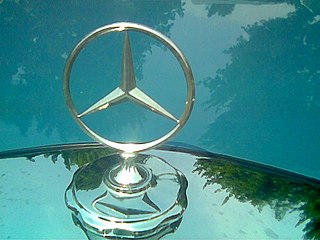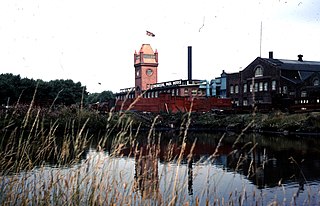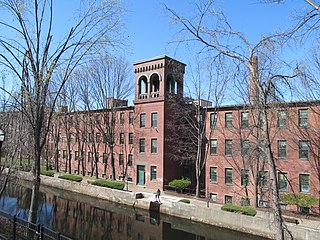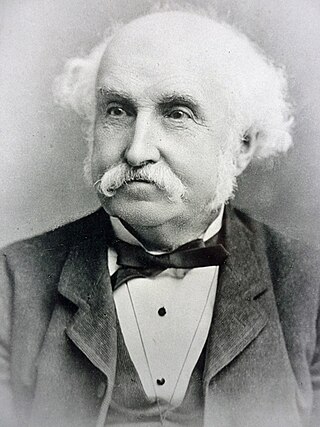
The Whitechapel Bell Foundry was a business in the London Borough of Tower Hamlets. At the time of the closure of its Whitechapel premises, it was the oldest manufacturing company in Great Britain. The bell foundry primarily made church bells and their fittings and accessories, although it also provided single tolling bells, carillon bells and handbells. The foundry was notable for being the original manufacturer of the Liberty Bell, a famous symbol of American independence, and for re-casting Big Ben, which rings from the north clock tower at the Houses of Parliament in London.
Sir David Brown was an English industrialist, managing director of his grandfather's gear and machine tool business David Brown Limited and more recently David Brown Tractors, and once the owner of shipbuilders Vosper Thorneycroft and car manufacturers Aston Martin and Lagonda.

Antoine-Louis Barye was a Romantic French sculptor most famous for his work as an animalier, a sculptor of animals. His son and student was the sculptor Alfred Barye.

Herbert Austin, 1st Baron Austin was an English automobile designer and builder who founded the Austin Motor Company. For the majority of his career he was known as Sir Herbert Austin, and the Northfield bypass is called "Sir Herbert Austin Way" after him.

ACF Industries, originally the American Car and Foundry Company, is an American manufacturer of railroad rolling stock. One of its subsidiaries was once (1925–54) a manufacturer of motor coaches and trolley coaches under the brand names of (first) ACF and (later) ACF-Brill. Today, the company is known as ACF Industries LLC and is based in St. Charles, Missouri. It is owned by investor Carl Icahn.

TheSpirit of Ecstasy Sculpture is a bonnet mascot of the Rolls-Royce cars. It is in the form of a woman leaning forwards with her arms outstretched behind and above her. Billowing cloth runs from her arms to her back, resembling wings.

The J. G. Brill Company manufactured streetcars, interurban coaches, motor buses, trolleybuses and railroad cars in the United States for nearly 90 years, hence the longest-lasting trolley and interurban manufacturer. At its height, Brill was the largest manufacturer of streetcars and interurban cars in the US and produced more streetcars, interurbans and gas-electric cars than any other manufacturer, building more than 45,000 streetcars alone.

The Canadian Car & Foundry Company, Limited was a manufacturer of buses, railway rolling stock, forestry equipment, and later aircraft for the Canadian market. CC&F history goes back to 1897, but the main company was established in 1909 from an amalgamation of several companies and later became part of Hawker Siddeley Canada through the purchase by A.V. Roe Canada in 1957. Today the remaining factories are part of Alstom after its acquisition of Bombardier Transportation completed in 2021.

A hood ornament, also called a motor mascot or car mascot, is a specially crafted model that symbolizes a car company, like a badge, located on the front center portion of the hood. It has been used as an adornment nearly since the inception of automobiles.

Bean Cars was a brand of motor vehicles made in England by A Harper Sons & Bean, Ltd at factories in Dudley, Worcestershire, and Coseley, Staffordshire. The company began making cars in 1919 and diversified into light commercial vehicles in 1924. For a few years in the early 1920s Bean outsold Austin and Morris.

The Gorham Manufacturing Company was one of the largest American manufacturers of sterling and silverplate and a foundry for bronze sculpture.
Vickers Limited was a British engineering conglomerate. The business began in Sheffield in 1828 as a steel foundry and became known for its church bells, going on to make shafts and propellers for ships, armour plate and then artillery. Entire large ships, cars, tanks and torpedoes followed. Airships and aircraft were added, and Vickers jet airliners were to remain in production until 1965.
Pietro Paulo Caproni (1862–1928) was founder and co-owner of PP Caproni & Brother, Boston, Massachusetts, manufacturers of plaster reproductions of classical and contemporary statues. These 'cast' reproductions were, in an era before commercial photography, an integral educational tool in teaching people the history of art and antiquities. The brother in the company's name was Pietro's brother, Emilio.
Pierre-Jules Mêne was a French sculptor and animalier. He is considered one of the pioneers of animal sculpture in the nineteenth century.

Hadfields Limited of Hecla and East Hecla Sheffield, Yorkshire was a British manufacturer of special steels in particular manganese alloys and the manufacture of steel castings.

Mather & Platt is the name of several large engineering firms in Europe, South Africa and Asia that are subsidiaries of Wilo SE, Germany or were founded by former employees. The original company was founded in the Newton Heath area of Manchester, England, where it was a major employer. That firm continues as a food processing and packaging business, trading as M & P Engineering in Trafford Park, Manchester.

Ames Manufacturing Company was a manufacturer of swords, tools, and cutlery in Chicopee, Massachusetts, as well as an iron and bronze foundry. They were a significant provider of side arms, swords, light artillery, and heavy ordnance for the Union in the American Civil War. They also cast several bronze statues, which can be found throughout New England.

Reginald Walter Maudslay was a British car manufacturer and founder of the Standard Motor Company. Born in Paddington, London, Maudslay was the son of Athol Edward Maudslay, "gentleman", and Kate, daughter of Sir Thomas Lucas, founder of a large firm of building contractors.

John Webb Singer was an English businessman who created a substantial art foundry in Frome, Somerset, known for its statuary and ecclesiastical products. He had assembled immense collections of antique jewellery, rings, wine glasses, snuffboxes, stamps. He took a prominent part in both local and national politics, serving on the Local Board and its successor the Urban District Council, founding the Frome Art School and helping to create the Frome Literary and Scientific Institution. He worked with the leading bronze sculptors of his day.
The Parlanti Foundry was an art bronze foundry located at the Albion Works, 59 Parsons Green Lane in Parsons Green, London, and was in operation from 1895 until 1917.














